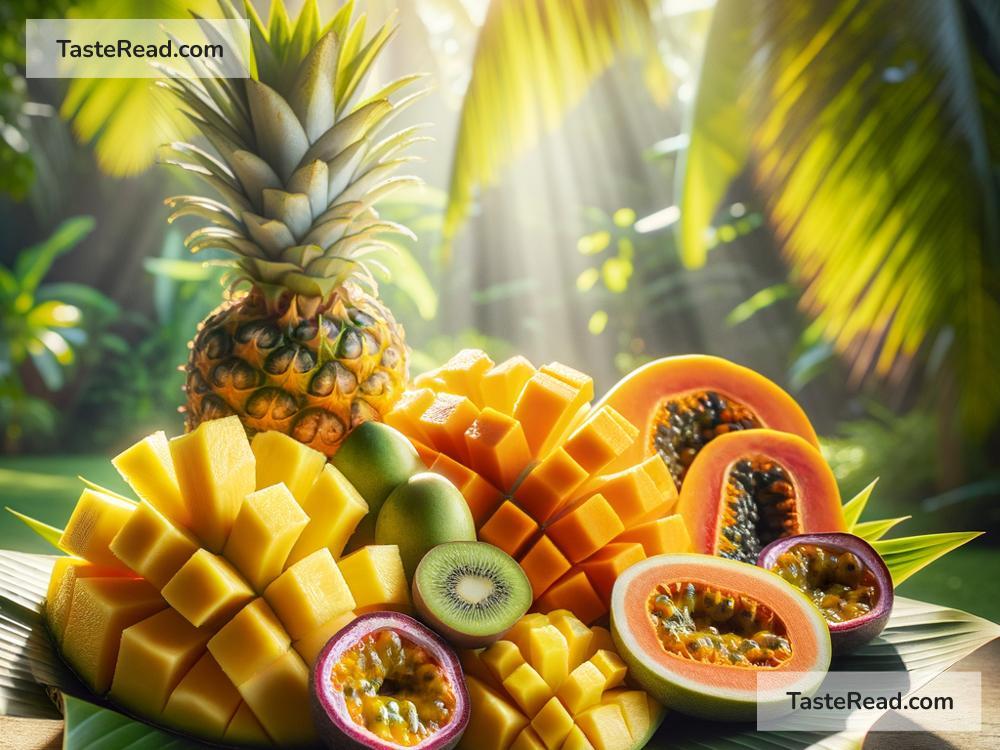Why Tropical Fruits Have Unique Taste Profiles
Tropical fruits are nature’s colorful candies. From sweet mangoes to tangy pineapples, these fruits have flavors that are often bold, exciting, and unforgettable. But why do tropical fruits taste so different from the fruits grown in cooler climates, like apples and pears? The secret lies in their environment, the way they grow, and their natural chemistry.
What Makes a Tropical Fruit?
Before diving into taste, let’s first understand what tropical fruits are. Tropical fruits come from regions near the equator, where it’s warm and humid all year round. Countries like Brazil, Thailand, the Philippines, and parts of Africa are famous for growing these fruits. These areas have plenty of sunshine, fertile soil, and abundant rainfall, which create the perfect conditions for growing fruits like mangoes, pineapples, papayas, bananas, and guavas.
Sweetness and Sunshine
One reason tropical fruits have such unique taste profiles is the long hours of sunshine they receive. Sunlight helps fruits produce more sugar as they grow. The more sugar a fruit contains, the sweeter it tastes. For example, mangoes ripen under sunny skies and develop their luscious, honey-like flavor. Similarly, bananas grow in tropical climates where the heat increases their natural sweetness. These fruits are like sunshine in edible form!
In cooler climates, fruits don’t experience as much constant heat and sunlight, so they tend to be less sweet and more tart or mild. That’s why apples and berries often have a mix of sweetness and acidity instead of the intense sweetness found in some tropical fruits.
Unique Acidity Levels
Tropical fruits often have a balance of sweet and sour flavors thanks to their unique acidity levels. Pineapple, for instance, is both tangy and sweet because of the natural acids inside it. Papayas, while milder in flavor, can have a slight tropical tang that makes them stand out. Guavas offer a mix of sweetness and sharpness that gives them their signature taste.
This tropical tang often comes from citric acid or other fruit acids, which thrive in warm weather. These acids help preserve the fruit by deterring pests and allowing the fruit to stay fresh longer, even in the hot and humid environments of the tropics.
Aroma: A Key to Flavor
When you bite into a ripe mango or slice open a papaya, the first thing you notice is their smell. Tropical fruits often have intense aromas that make them extra appealing. That’s because these fruits contain special compounds called esters and terpenes. These chemicals give tropical fruits their distinct fragrances, like the sweet floral scent of guavas or the tropical coconut smell of durian.
Fruits grown in cooler areas may have milder scents. For example, apples have a pleasant but subtle aroma. Meanwhile, tropical fruits are like nature’s perfume bottles—they grab your attention before you even taste them.
Diversity in Natural Chemistry
Tropical fruits don’t just have sugar and acids—they also contain a wide range of vitamins, minerals, and antioxidants that add to their unique taste. For example:
- Mangoes are rich in vitamin C and beta-carotene, which not only make them sweet and juicy but also give them their bright orange color.
- Passion fruit contains natural compounds that give it a tart and floral taste.
- Lychees are loaded with sugars, making them super sweet, but they also have a light floral undertone that makes them taste special.
The variety of nutrients and compounds found in tropical fruits is partly due to their growing conditions. Warm climates encourage fruits to develop these unique chemical profiles.
Adaptation to Tropical Weather
Tropical fruits have also evolved to survive in their hot and humid environments. To attract animals that help spread their seeds, these fruits often develop bold flavors and bright colors. For example, a ripe mango’s bright orange or red skin tells animals (and humans!) that it’s ready to eat. Similarly, the sweet and tangy taste of a pineapple makes it irresistible, encouraging animals to consume it and spread its seeds.
In contrast, fruits grown in cooler climates have adapted to different needs. They may have subtler flavors and tougher skins to survive in harsher conditions.
Our Love for Tropical Fruits
Tropical fruits are beloved worldwide not only for their taste but also for their exotic appeal. Many of these fruits remind people of vacations, sunny beaches, or faraway places. They aren’t just delicious—they’re a way to experience the tropics without traveling. Plus, tropical fruits are highly versatile. You can eat them fresh, blend them into smoothies, use them in desserts, or even cook them in savory dishes.
Conclusion
Tropical fruits have unique taste profiles because of the special conditions they grow in—warm weather, lots of sunshine, and humid environments. Their sweetness, acidity, aroma, and vibrant chemistry all combine to create unforgettable flavors. Whether it’s the juicy sweetness of a mango or the tangy zest of a pineapple, tropical fruits offer a sensory experience like no other.
The next time you eat a tropical fruit, take a moment to savor its taste and think about the sunny, lush environment it came from. It’s like taking a small bite of paradise!


